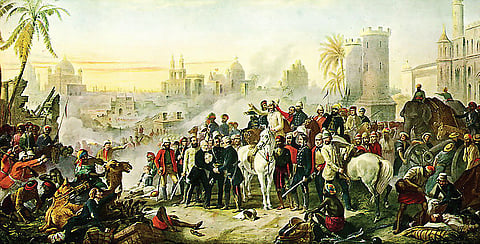Tales From a Vanished Past
Asked to review a particular book, Abraham Lincoln is said to have responded by saying, “People who like this sort of thing will find this the sort of thing they like.” Shamsur Rahman Faruqi’s The Sun that Rose from the Earth is precisely the sort of book that those who like leisurely and erudite books will like. A collection of five stories, each a fairly long short story, originally written in Urdu and admirably translated into English by the author himself, The Sun that Rose… is not the right fare for light readers on the go or casual reading for the frivolous-minded; every single one of its 600-odd pages is a connoisseur’s delight, brimful with evocative detail and flavoursome with the choicest of Urdu verses. It requires patience and attention, not to mention stamina to read even one story in one sitting.
As in the case of his previous book, The Mirror of Beauty, first written in Urdu as Kai Chand Thhe Sar-e Asman and subsequently published in its English translation to great critical acclaim, The Sun... evokes a vanished past not merely with a historian’s eye for perfect detail but with an aesthete’s sensibility for all that is fine and rare in life and letters. The stories are set in a cusp of time when two worlds are fusing and merging: the rays of the setting sun are bathing Mughal India in the warm glow of its last rays and a colonial India—with its “English-style madrassas”, vilayati cloth and other commodities flooding the shops and bazaars that are rife with rumour and gossip about the latest political intrigues —is coming into its own.
Beni Madho Singh ‘Ruswa’, the young protagonist of the first story ‘Bright Star, Lone Splendour’, travels from Azamgarh to Delhi to meet an ageing Mirza Ghalib. By then a lion in winter, Ghalib recites a Persian verse of his to his callow provincial visitor:
My station cannot be discerned by any eyes but mine
For my star is so far up that it doesn’t shine bright.
Writing a memoir of that fateful meeting, Ruswa conjures up scores of people, Rajas and nawabs, dastango and poets, even a pretty hostess at an inn who spoke “beautiful Urdu with quiet elegance and who (still) regarded Mirza Ghalib sahib as an outsider and not a native of Delhi”—character, both real and imagined who were “gobbled up like a python swallowing a small bird” by the events unspooling from 1857, the annus horribilis.
Showing a propensity for deliberately using archaic words and expressions in keeping with the historical nature of his work as well as different registers and intonations for different characters to denote their class and caste distinctions, Faruqi studs his narrative with a profusion of Urdu poetry which convey the “culture” of his settings far more effectively than dialogues or reported speech. Wit and repartee, the cut and thrust of civilized banter, punning and wordplay, ingenious use of a word with many meanings, all this and more is inserted into the leisurely narrative through explanatory asides. For instance, “zila” meaning “side” was used “to mime the language from unlikely angles and use free play of association as a weapon of wit…With the decline of culture, the art of zila fell into disrepute, then desuetude. It was, in fact, not just frivolity, but could be used in poetry with much effect by the ingenuous poet. Mir used it often and with such subtlety that all but the most discerning listeners failed to get the zila angle. The effect of zila is impossible to reproduce in translation, but here are a few examples from the poetry of Mir, with the necessary commentary:
How I wish I was one of this garden: like the scent of flowers
I’d float with the morning breeze, enjoy myself, and then dissipate, like air.”
And so it goes on: leisurely commentary, erudite asides on poetics, keen observations on society, culture and manners coming together in a seamless whole. And so, while the five stories are neither long short stories, nor novellas or even novels in the conventional sense, they are a valuable introduction to a vanished past. That Faruqi has re-imagined many historical figures and real events and brought them to life for the modern reader in a richly textured, elegantly sprawling work of fiction is a testimony to his creative prowess.

